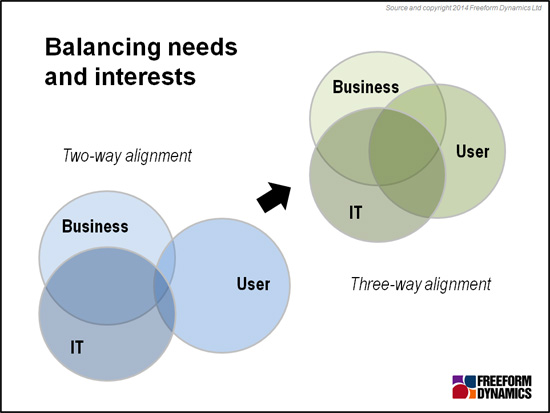User expectations and the range of devices they use to access IT systems are growing rapidly. In particular, users now feel they should be able to reach all IT systems and applications, at any time, from anywhere, using any device. This puts great pressure on organisations to match their demands and simultaneously keep costs under control and maintain corporate security.
These pressures will force IT groups to find new ways to manage the expanding range of user device types. Furthermore, IT and business managers will need to rebalance their approach to making many of their IT / System decisions. (Figure 1.)

Figure 1
Until recently, organisations based their desktop and laptop solution choices on business requirements and the ability of IT to support possible new systems. User requirements were frequently of only secondary importance.
But things are changing and user expectations have become a major consideration for both IT and business decision makers. As the figure illustrates, many organisations may now have to finely balance the needs of IT, business and the desires of its users.
This does not mean that the desires of users should supersede primary business requirements for security nor adversely impact the ability of IT to manage the systems effectively and efficiently. Eventually a new equilibrium point will be reached, but getting there may not be simple.
Desktop virtualisation offers one possible way to address the challenges facing IT as it finds itself supporting an expanding raft of devices with severe resource constraints. Recent years have been littered with questionable claims that the era of desktop virtualisation has finally arrived. Now, with some help from the channel, adoption could well accelerate.
Several factors help make the case. As has been mentioned above, the needs of business to allow staff to use new devices are very powerful, especially in areas where new business processes can be adopted. Add to this the desire of users to work from anywhere, using any device (including those they own), makes the business case for desktop virtualisation more straightforward.
It is also clear that the ability of the back-end IT infrastructure to support desktop virtualisation economically has improved dramatically recently. This applies particularly to storage platforms that would often become a bottleneck at times when usage was high, namely the notorious 9am Monday morning boot storm, when response times could drop alarmingly. Virtualisation infrastructure costs have shrunk thanks to the widespread availability of SSD platforms, coupled with the growing maturity of the management capabilities of desktop virtualisation platforms.
That said, while desktop virtualisation solutions are currently high profile, the different approaches are little understood. It is fair to say that few organisations have a good idea of which type of desktop virtualisation approach might suit different work style needs and business security / management requirements.
These are areas where channel vendors could help customers greatly. Indeed, an opportunity exists for channel partners to undertake usage requirements and inventory support discovery processes, both of which are essential to any successful desktop virtualisation project. (See further reading).
Organisations undertaking desktop virtualisation will need to take a fresh look at their IT systems. To be most effective and to reduce resource usage, desktop virtualisation should encourage a new way of looking at desktops, essentially to logically break the link between the operating system, applications, user data and the user’s preferences. (Figure 2.)

Figure 2
Logically breaking up desktop components into buckets covering applications and data used, the security policies to be enacted, and the users’ personalisation preferences such as favourites, style etc. maximises the potential to keep virtualised desktops manageable with least effort over time. This approach also minimises the need for central storage, which is no small consideration.
However, the approach will have most effect in the long-term management of systems where the number of gold builds can be minimised, hopefully resulting in a reduction of IT time to keep said images patched, assigned to users as their work patterns alter, new applications have to supported or old applications removed etc.. The opportunities for channel vendors to get involved range from basic implementation services and support infrastructure sales to long term managed services to keep desktop virtualisation solutions running, perhaps even to host cloud-based solutions.
Don’t expect a tidal wave of desktop virtualisation, but increasing numbers of organisations are adopting various solutions. The potential use cases for effective solutions are now very broad, but organisations need help to work out what they need to do, the best solutions to adopt, as well as help running things. The door is ajar, are you ready to push it wide open?
Further reading:
The following eBooks are available for free download from the Freeform Dynamics website:
Desktop Virtualization. Aligning options with user and business requirements.
User Virtualization. Beyond device-centric computing.

Registration required